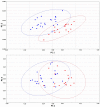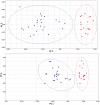A Different Perspective on Sex Dimorphism in the Adult Hermann's Tortoise: Geometric Morphometry
- PMID: 34386094
- PMCID: PMC8315924
- DOI: 10.6620/ZS.2021.60-09
A Different Perspective on Sex Dimorphism in the Adult Hermann's Tortoise: Geometric Morphometry
Abstract
Eastern Hermann's tortoise (Testudo hermanni boettgeri) is a subspecies of Hermann's tortoise (Testudo hermanni) found in Albania. Gender determination is one of the crucial elements in determining the population dynamics in all species. Female and male adult tortoises look different, but these differences can be difficult to distinguish in captivity or when their sex indicators are deformed or injured. Therefore, the aim of this study was to use indirect and non-invasive methods such as geometric morphometric analysis to determine the sex of adult tortoises. For the geometric morphometry, 17 female and 23 male Hermann's tortoises were collected and photographed from the hills and mountains around the Tirana district of Albania between August and October 2019. Sexes were discriminated based on geometric morphometry, and plastron shape was a better indicator than carapace shape. In addition, abdominal, femoral and anal scutes on the plastron and the ratio of femoral to pectoral suture lengths were important for the sex distinction. Females had a larger plastron than males; this may have been supported by fecundity selection, because a large plastron suggests more volume in which to store eggs. The femoral and anal scutes were larger in male tortoises, and serve as a stronger base during mating. This study was conducted for adults only, and future studies are needed to determine if these indicators also apply to hatchlings and juveniles.
Keywords: Abdominal scutes; Albania; Geometric morphometry; Sex discriminate; Testudo hermanni boettgeri.
Figures





References
-
- Auliya M, Altherr S, Ariano-Sanchez D, Baard EH, Brown C, Brown RM, Hintzmann J. 2016. Trade in live reptiles, its impact on wild populations, and the role of the European market. Bio Conserv 204:103–119. doi:10.1016/j.biocon.2016.05.017.
-
- Bernal V. 2007. Size and shape analysis of human molars: comparing traditional and geometric morphometric techniques. Homo 58(4):279–296. doi:10.1016/j.jchb.2006.11.003. - PubMed
-
- Biaggini M, Corti C. 2018. Facing Habitat Reduction in Your Own Shell: Patterns of Non-lethal Injuries in the Endangered Tortoise Testudo hermanni in Italy. Herpetol Conserv Bio 13:539–550.
-
- Böhm M, Collen B, Baillie JE, Bowles P, Chanson J, Cox N, Rhodin AG. 2013. The conservation status of the world’s reptiles. Bio Conserv 157:372–385. doi:10.1016/j.biocon.2012.07.015.
-
- Bulmer M. 1994. Theoretical evolutionary ecology. Sinauer Associates, Inc., Sunderland, MA, USA.
LinkOut - more resources
Full Text Sources
